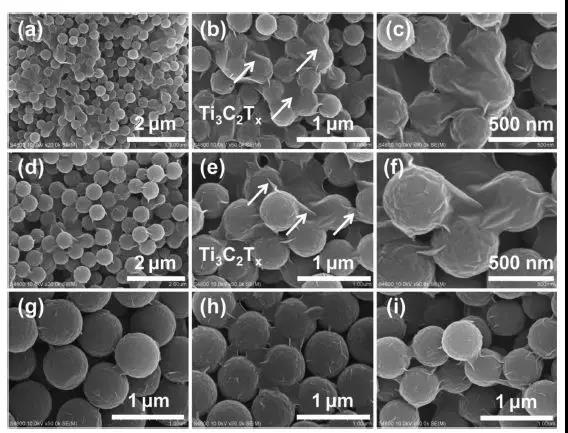3D Network with Classic
QQ Academic Group: 1092348845
Detailed
Polymer-based conductive nanocomposites have broad application prospects in the fields of intelligent electronics, energy equipment, electromagnetic interference (EMI) shielding, and aerospace due to their light weight, strong corrosion resistance, good processing properties, and strong versatility . Generally speaking, the conductive nanocomposites of polymers mainly depend on the intrinsic conductivity, aspect ratio, amount and distribution of the filler . Higher filler loadings then often result in poorer mechanical and processing properties.
2D transition metal carbide / carbonitride (MXene) has ultra-high intrinsic conductivity, large specific surface area and excellent mechanical properties, and has excellent EMI shielding performance. 3D structures have proven to be an effective way to achieve higher electrical conductivity at lower filler levels. Therefore, the 3D MXene conductive network is expected to solve this problem.
Achievements
Recently, Professor Yu Zhongzhen and Zhang Haobin from Beijing University of Chemical TechnologyIn the internationally renowned journalAdvanced Functional MaterialsPublished a paper titled " Highly Conductive Transition Metal Carbide / Carbonitride (MXene) @polystyrene anocomposites Fabricated by Electrostatic Assembly for Highly Efficient Electromagnetic Interference Shielding " , which was prepared using the electrostatic "packaged ball" method-electrostatic self-assembly-molding method Highly conductive MXene @ PS nanocomposite. Due to the high conductivity of MXene and the highly efficient conductive network within the polystyrene matrix, the nanocomposite materials not only have a low penetration threshold of 0.26 vol%, but also exhibitshielding effectivenessof up to 1081 S m−1and 54 dB. It has huge application potential in the field of electromagnetic shielding.

Figure 1 MXene @ PS nanocomposite preparation mechanism diagram .

Figure 2 Structure and morphology of MXene .

Figure 3 Chemical composition of MXene @ PS .

Figure 4 The appearance of MXene @ PS ball .

Figure 5 Morphology and microstructure of MXene @ PS nanocomposites .

Figure 6 Threshold permeability network and shielding performance of MXene @ PS nanocomposites .

Figure 7 Mechanical properties of MXene @ PS nanocomposites .
in conclusion
A highly conductive MXene @ PS nanocomposite was prepared by electrostatically assembling negatively charged MXene nanosheets and positively charged PS microspheres and then compression molding . The highly conductive MXene nanosheets are located at the interface of the large PS microspheres to form a continuous and efficient conductive network, providing ultra-high electrical conductivity and excellent electromagnetic shielding performance. The threshold permeability is only 0.26 vol% , and the conductivity of 1.90 vol% MXene / PS nanocomposite is as high as 1081 S m −1 , which provides good electromagnetic interference shielding performance of nanocomposites, and the electromagnetic shielding performance in the entire X-band reaches Above 54 dB, the maximum shielding is 62 dB. The 3D conductive network effectively multi-reflects and attenuates electromagnetic waves, making the electromagnetic shielding mechanism mainly absorption. In addition, there MXene @ PS nanocomposites having a reservoir much higher than that of pure PS storage modulus. A novel method of polymer nanocomposite prepared by electrostatic assembly with excellent electrical conductivity, mechanical properties and electromagnetic shielding propertieswill broaden the application field of MXene nanomaterials.
Original link:
https://doi.org/10.1002/adfm.201702807
Source: MXene Academic
- Previous: Ultrathin MXene Prepar
- Next: MXene breakthrough: Na


 mxene academic
mxene academic
